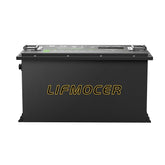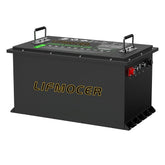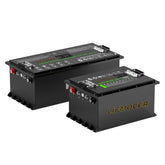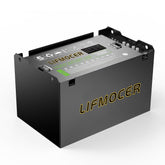Lithium Forklift vs. Lead-Acid: Which Battery Is Better?
In the modern warehouse landscape, efficiency and sustainability are paramount. As companies seek cleaner, smarter, and more cost-effective solutions, lithium forklift has surged in popularity. Compared to traditional lead-acid battery forklifts, lithium-powered options offer compelling advantages—but are they truly better? Let's examine the key differences to help you make an informed decision.
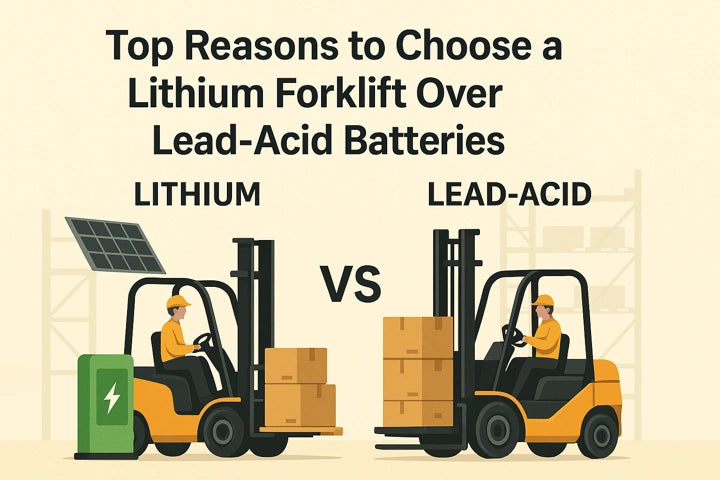
Lithium Forklift Battery vs. Lead Acid Battery Performance and Efficiency
One of the core advantages of lithium forklift is the ability to output power continuously and stably. Compared with the characteristic of lead-acid batteries that the voltage gradually decays during the discharge process, lithium battery can maintain a constant voltage platform throughout the charge and discharge cycle, ensuring that the forklift maintains stable power output and long-lasting endurance when lifting goods, especially in the case of long-term or multi-shift operations. This voltage stability avoids the decline in efficiency caused by the drop in the mid-range voltage of the lead-acid battery system, providing a reliable guarantee for the efficient operation of warehouse logistics.
In addition, lithium batteries are also excellent in charging speed and energy efficiency. The full charging process can usually be completed within 2 hours, while the lead-acid battery system not only requires up to 8 hours of charging time, but also requires an additional cooling cycle. More importantly, lithium-ion batteries support "Opportunity Charging", allowing short-term charging during the operation interval of lithium forklifts without affecting the battery life. This flexible charging feature greatly reduces equipment downtime and increases the utilization rate of lithium forklift by more than 40%. At the same time, its energy conversion efficiency exceeds 90%, which is much higher than the 65%-70% efficiency of lead-acid batteries. When used in conjunction with an intelligent energy management system, it can significantly reduce operating energy costs.
Lithium Forklift Battery vs. Lead Acid Battery Maintenance and Operation
The core defect of lead-acid batteries is that they require frequent daily maintenance - including regular replenishment of electrolyte, cleaning of electrode terminals, ensuring ventilation and performing balanced charging procedures. These time-consuming tasks increase labor costs and are accompanied by safety hazards such as acid leakage and gas explosion. In contrast, lithium-ion forklifts use sealed batteries with integrated battery management systems (BMS), which automatically monitor voltage, temperature and charge and discharge status through intelligent algorithms, fundamentally eliminating electrolyte evaporation losses, and can achieve fault diagnosis and performance optimization without human intervention, significantly improving the battery safety and management efficiency of warehouse operations.
Cost: Upfront vs. Long-Term Investment
While lithium forklifts carry a higher upfront cost, they often deliver greater return over time. Their longer battery service life, lower energy consumption, and minimal battery maintenance requirements lead to significant cost savings across the forklift’s lifecycle.
| Feature | Lithium Forklift | Lead-Acid Forklift |
|---|---|---|
| Battery Lifespan | 3,000–5,000 cycles | 1,000–1,500 cycles |
| Battery Charging Time | 1–2 hours | 6–8 hours + cooldown |
| Maintenance Required | Minimal | Frequent (watering, cleaning) |
| Total Cost of Ownership | Lower over time | Higher due to upkeep |
Lithium Forklift Battery vs. Lead Acid Battery Environmental Impact
As companies face increasing pressure to reduce carbon emissions, the environmental benefits of lithium-ion forklifts are becoming more and more significant. They achieve zero tail gas emissions throughout their life cycle and consume less power than traditional lead-acid forklifts. In addition, they are compatible with solar charging stations, forming a closed loop of "green power production - storage - consumption", providing hardware support for companies to achieve carbon neutrality operation goals.
In contrast, lead-acid battery technology releases hydrogen when charging, which poses the risk of acid leakage and heavy metal pollution. Electrolyte leakage may cause soil and water pollution. If lead, sulfuric acid and other substances in the battery are not properly handled, they are prone to heavy metal chain pollution. Although lead-acid batteries are recyclable, their regeneration requires complex processes such as high-temperature melting and acid-base neutralization, accompanied by high energy consumption and harmful gas emissions, and companies need to bear additional environmental compliance costs.
Where Lithium Forklift Shine
Lithium-powered forklifts are especially suited for operations where uptime, safety, and efficiency are critical. Consider investing in a lithium forklift if your operation includes:
- Multiple or continuous work shifts
- Strict hygiene and safety standards (e.g., food, pharma)
- Limited space for battery maintenance and ventilation
- Green logistics initiatives or energy-conscious infrastructure
In such environments, the benefits of forklift battery technology far outweigh the higher initial investment.
Conclusion: A Smarter Choice for the Future
In the selection decision of forklift batteries and lead-acid forklifts, the core considerations are the operational scenario requirements, initial budget allocation and the company's long-term strategic planning. Although lead-acid forklifts have short-term advantages in terms of purchase cost, their maintenance-intensive, low energy efficiency and environmental compliance risks make them gradually difficult to adapt to scenarios with high-frequency operations in multiple shifts, strict environmental standards or the pursuit of low-carbon transformation.
On the other hand, lithium battery forklifts are more efficient and safer in high-frequency operations due to their stable voltage output, intelligent maintenance-free design (integrated BMS system), zero emission characteristics and renewable energy compatibility. Although the initial investment is 20%-30% higher, its long life (over 6,000 cycles, 6 times that of lead-acid), low energy consumption (40% electricity saving) and maintenance-free advantages reduce the 3-5 year total cost of ownership (TCO) by more than 45%.
Therefore, for modern warehousing that pursues efficient operations, assumes environmental responsibility and focuses on long-term cost optimization, lithium-ion forklifts have gone beyond the scope of equipment selection and become a strategic investment to support the upgrade of the logistics system.


